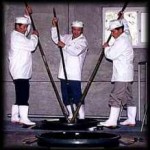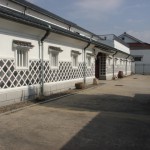What is happening in the brewing world itself…
Changing Sake Flavor Profiles
A survey by the Ministry of Taxation on sake flavor profiles for last year showed a couple of interesting trends.
 In short, the trend for junmai-shu to be both drier and richer continued. For better or for worse, more intense junmai has become more popular. Also, in ginjo-shu, the alcohol content and amount of a compound called ethyl caproate (think “apples” in your ginjo) also increased. So brewers are taking the sake of those grades further into their archetypal manifestations. Overall acidity of premium sake stayed pretty much the sake, but the umami-yielding amino acid content dropped a bit. The sweet/dry and richness of non-junmai premium sake (basically ginjo-shu) also stayed the same.
In short, the trend for junmai-shu to be both drier and richer continued. For better or for worse, more intense junmai has become more popular. Also, in ginjo-shu, the alcohol content and amount of a compound called ethyl caproate (think “apples” in your ginjo) also increased. So brewers are taking the sake of those grades further into their archetypal manifestations. Overall acidity of premium sake stayed pretty much the sake, but the umami-yielding amino acid content dropped a bit. The sweet/dry and richness of non-junmai premium sake (basically ginjo-shu) also stayed the same.
While this may not be so useful in our everyday sake sipping endeavors, it is interesting to hover over and observe the changes and trends.
Special Clause 87 Extended Again
In January, the Ministry of Taxation again extended Special Clause 87 for a couple of years. As you all likely remember, SC87 gives tax breaks to smaller brewers, which means almost everybody, since the industry is so polarized.
How polarized? Out of 1260 breweries, about 15 make about 50% of the sake. About 1000 are very, very small.
The original clause gave a 30% break to these smaller brewers, and as it expired, the industry (well, most of it!) sought a permanent extension. The compromise was a 20% break for five more years (actually, it is a bit more complicated than that, but that is the gist). So the can has been kicked down the road a bit, but hopefully, over the next five years, profits will rise, and will not stand to lose the hundreds of brewers we might have lost this time, had it expired.
Yamada Nishiki Shortage
The harvest of Hyogo-Prefecture-grown Yamada Nishiki last year was down for a handful of reasons, and the impact is being felt throughout the industry.
The rice grown is sold to the Brewers Associations of the various prefectures, rather than to individual brewers. And Hyogo Prefecture has told at least a few prefectures that they would only get 88% of what they ordered.
It was indeed a less-than-copious harvest. But there are other reasons and rumors swirling about too. While keeping the homeboys of Hyogo and the most important customers happy before supplying those far away is certainly part of it, there is more. For example, one source told me (on condition of anonymity) that the Tohoku region sold a lot of sake fast after 3/11/11, and needed to outsource some of that from Western Japan, who then needed to replenish their stocks, hence driving demand for Yamada up. Another source said that Hyogo Prefecture tightened their standard for top-inspected-grade “Tokujo” Yamada Nishiki to raise the image of Hyogo-grown Yamada, thus lessening the supply of same. There are other interpretations as well.
In any event, this and the fact that there have been overall price increases on most rice this year means we may see an increase in sake prices come next fall.





